#sharptail mola
Text
Wet Beast Wednesday: ocean sunfish
Everybody knows ocean sunfish, right? Those giant, slow, silly-looking, parasite-ridden morons that eat jellyfish and can't defend themselves from predators really are the worst fish right?

(GIF: Lex Luthor screaming "WRONG!" from the movie Superman Returns)
First of all there's no such thing as a "best" or "worst" animal and judging animals by human standards of what is cool or successful is silly because our standards are not even universal among humans, let along other species. Secondly, the closest thing we have to a way to judge a species is how successful it is in its niche and sunfish are doing pretty good, thank you very much. Today I'll be talking about sunfish and how they are not bad fish at all.
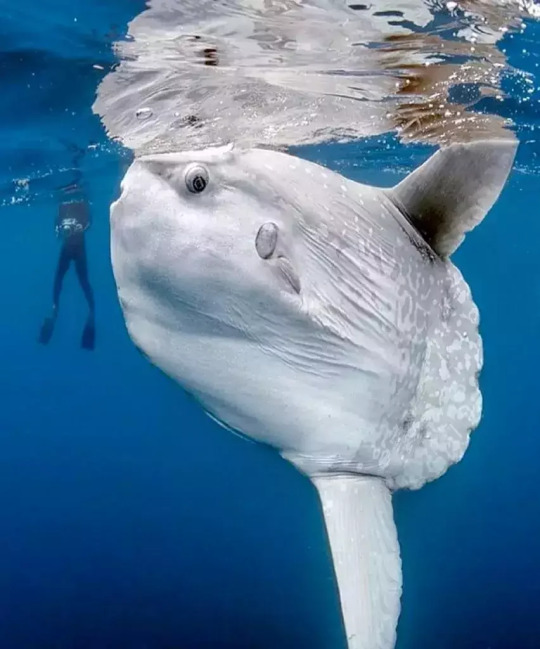
(Image: a Mola mola located near the surface of the ocean, with the tip of its dorsal fin and part of its head breaching the surface. It is a round fish with no tail, only a wrinkly region of its body. Its dorsal and anal fins are long and slender The eyes and mouth are proportionately small. It is a pale white with light grey spots. A SCUBA diver is visible in the background. End ID)
Ocean sunfish, or molas, are members of the family Molidae, which is divided into five known species across three genuses. Im mostly going to be talking about members of the genus Mola, but I'll mention the other two as well. Molas are known for their size and odd appearances, looking like someone chopped a fish in half and the front half went swimming off on its own. They are members of the order Tetraodontiformes, making them cousins to pufferfish, triggerfish, boxfish, and others. While many members of that order are known to be highly poisonous, molas are not. They also lack several other common traits. Despite being bony fish, most of the mola skeleton is made of cartilage and they do not have swim bladders, forcing them to actively swim to maintain their position in the water column. Instead of a tail and caudal fin, sunfish have a structure called the clavus. The clavus is formed mostly from connective tissue and is used as a rudder. Because the clavus is mostly made of connective tissue, damage to it is not particularly harmful to the fish. There have been molas found alive and well that have had portions of their clavus eaten by predators. Because of their shortened stature, molas have the fewest vertebrae of all fish. The dorsal and anal fins are elongated and are used to provide propulsion by flapping back and fourth similarly to how birds wings move, albeit slower. Minute alterations in the angle each fin moves through the water help with steering, while more sharp turns are aided with jets of water ejected through the mouth and gills. Like their other Tetraodintid relatives, mola teeth are fused together into a beak-like structure that prevents them from closing their mouths. They also have some more regular pharyngeal teeth in the backs of their mouths. Some reports say that the fish can make noises by grinding the pharyngeal teeth together. Mola skin is thick and rough, described as being similar to sandpaper in texture. Like most fish, the skin is covered in a layer of protective mucus.

(Image: a mola sunbathing. It is positioned with one side of its body facing the surface. Its body is just under the water's surface. End ID)
The three species in the genus Mola are Mola mola, the ocean sunfish and most well-known of the molas, Mola alexandrini, the giant, southern, or bumphead mola, and Mola tecta, the hoodwinker sunfish. Mola mola has an average weight of 247 to 1000 kg (545 to 2205 lbs), mouth to clavus length of 1.8 m (5.9 ft) and dorsal to anal fin length of 2.5 m (8.2 ft), though some individuals can get much large. The largest individual on record had a length of 3.3 m (10.8 ft), height of 3.2 m (10.5 ft) and weighed 2300 kg (5100 lbs). M. alexandrini is the largest of the species. The largest known southern sunfish measured in at 2744 kg (6049 lbs) and 3.25 m (10.66 ft) from mouth to clavus, making it the largest known bony fish in the world. They can be distinguished from M. mola by the presence of bumps on the forehead and chin, a more rounded clavus, and differently-shaped scales. M. tecta is known as the hoodwinker sunfish because it was long mistaken for one of the other two species and was only identified as a separate species in 2015 after the body of one washed up in Christchurch, Aotearoa/New Zealand and was examined by scientists. Because it has only recently been discovered, little is known about this species. They appear to have the same range of sizes and weights of the other two species and can be distinguished by a slimmer body shape and a smooth clavus. All three species are found in tropical and temperate waters worldwide, though M. alexandrini and M. tecta are more commonly found in the southern hemisphere.
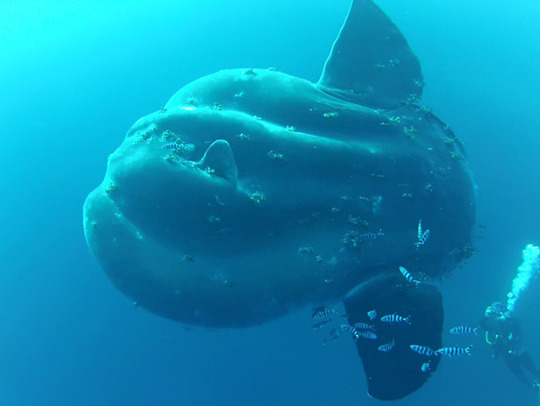
(Image: a Mola alexandrini underwater. It is distinguishable from Mola mola by the two bumps above and below its facial region, making it look lumpy. It is surrounded by striped cleaner fish. A SCUBA diver is in the background. End ID)
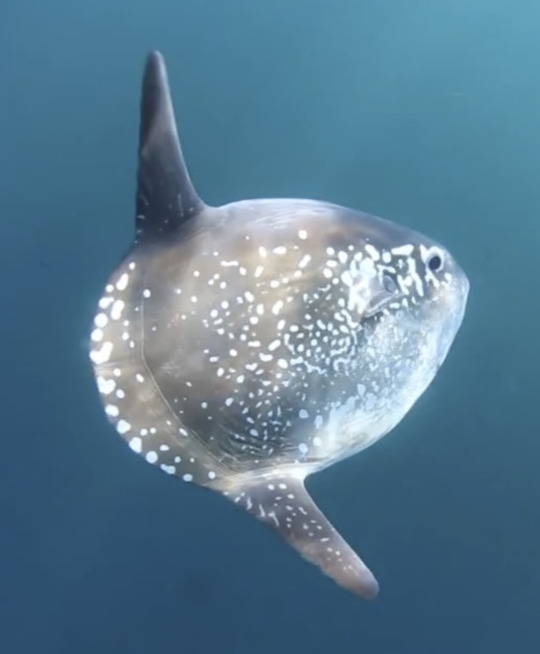
(Image: a Mola tecta seen from the side. It is smoother than the other two species. More of its body is grey with white spots. End ID)
Molas are open-ocean dwellers that live life in the slow lane. For a long time, it was believed they were moved around by ocean currents they could not swim against, making them plankton. We now know they not only can swim against the current, they are capable of bursts of speed fast enough to breach the water's surface and briefly go airborne. Sunfish are named for their habit of basking at the surface of the water. It was formerly believed they spent most of their time at the surface, but thanks to tagging, we know they make frequent dives into the deep ocean. They likely bask at the surface to warm up between dives. You may not expect something as slow as a sunfish to be a predator, but they are. Much of their diet consists of gelatinous animals including jellyfish, siphonophores, ctenophores, and salps, though they will also eat small fish, fish larvae, squids, crustaceans, and even seagrass. Because they can't chew, sunfish move prey into and out of their mouth by rapidly switching between sucking water in and spitting it out in order to shred the prey into pieces small enough to swallow. Special mucus lining the digestive system may protect the molas from the stinging tentacles of their prey. Molas and other jellyfish-eaters like the leatherback sea turtle play an important role in the ecosystem by keeping jellyfish populations down. Jellyfish are not particularly nutritious, so the sunfish need to eat a lot of them to survive, something they seem to be pretty good at. Being slow and having a very low-energy lifestyle helps the fish survive on a less-nutritious diet, making them very energy efficient. One thing molas get a lot of flack for online is having lots of parasites (with up to 40 known species). This doesn't really make sense. Every species has parasites. An animal in the wild that doesn't have parasites is vanishingly rare. Having parasites doesn't make an animal suck, it makes them ordinary. Because of their parasite load, molas are frequent visitors to cleaner fish, who will eat their parasites. Molas will also let seabirds land on them and eat their parasites while they rest on the surface. The molas attract birds by splashing at the surface. Adult molas have few natural predators, but are hunted by sharks, sea lions, and orcas. Interestingly, sea lions have been known to kill molas apparently for sport, ripping off the fins and then leaving the mola to die.

(Image: a mola seen from the front. Multiple smaller fish are picking parasites off of its skin. End ID)
Molas are broadcast spawners who release their gametes into the water alongside each other. A female mola can release 300 million eggs at a time, more than any other vertebrate. Newly hatched sunfish are 2.5 millimeters long and are often cited as having the largest discrepancy in size between juvenile and adult of any vertebrate. An adult mola can be 60 millions times the weight of a larva. The larvae look very different than adult, lacking their dorsal and anal fins but having pufferfish-like spines. Juveniles school together for protection and become solitary as they age. The diet of the fish varies as they age, with younger fish feeding more on squid, worms, crustaceans, and fish but becoming more reliant on jellyfish and other gelatinous prey as they age. We don't know the growth rate of molas, but a juvenile in the Monterey Bay Aquarium grew from 26 to 339 kg (57 to 880 lbs) in 15 months, suggesting they grow rapidly. The maximum age of molas is unknown, though individuals in captivity have lives for up to 10 years.

(Image: a mola larva. It is a brown ball with large, black eyes and no visible fins. It is covered in transparent, conical spines. End ID)
The two non-Mola sunfish are Ranzania laevis, the slender sunfish and Masturus lanceolatus, the sharptail sunfish. Both are alone in the genuses, but other species are suspected. I also found references to other species in Masturus, but could find literally no information about them other than that Masturus oxyuropterus is listed in some records. The sharptail sunfish looks very similar to Mola mola and reaches similar sizes, but its clavus has an extension that looks like a short tail. They were initially believed to be deformed molas before being recognized as a separate species. Unlike molas, sharptail sunfish are rarely seen at the surface, preferring to stay in deeper water. The slender sunfish is the smallest of the family, reaching up to a meter long. While we don't know much about them, we know their diet includes a lot of fast-moving squid, indicating they can move faster than their much larger relatives.
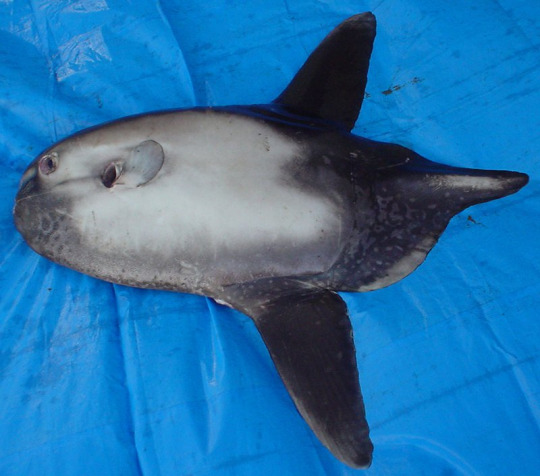
(Image: a sharptail sunfish lying on a blue tarp. It looks similar to a Mola mola , but with black clavus and fins. At the back of the clavus is a triangular extension. End ID)
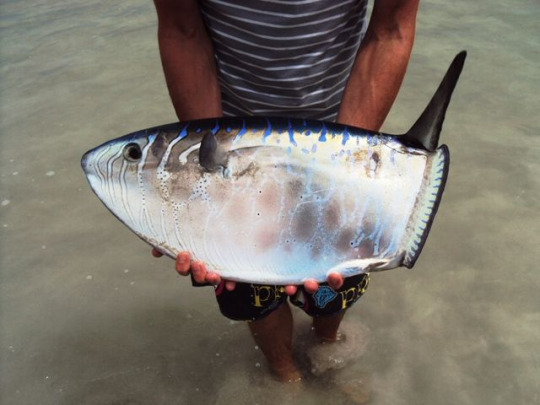
(Image: a person holding a slender sunfish. The fish is small enough to be held and has a longer and skinnier body than other sunfish. Its body is a shiny silver with blue lines. End ID)
Mola mola is classified as vulnerable by the IUCN while the other species are classed as either data deficient or least concern. Molas are vulnerable to strikes by boats and bycatch. Another danger to them is plastic bags, which can easily be ingested after being mistaken for a jellyfish. The bags can suffocate the fish or block their digestive tracts. Despite their size, molas are docile and not dangerous to humans. I found one example of a mola harming a human and it happened when the fish jumped out of the water and landed on a boat. Allegedly, some fish have learned to recognize and approach SCUBA divers. Molas are difficult to keep in captivity due to their size, the amount of space the need, and special feeding needs, so only a few aquariums have them. Molas are captured for food, with the biggest markets being in Taiwan and Japan, where they are often called mambos.
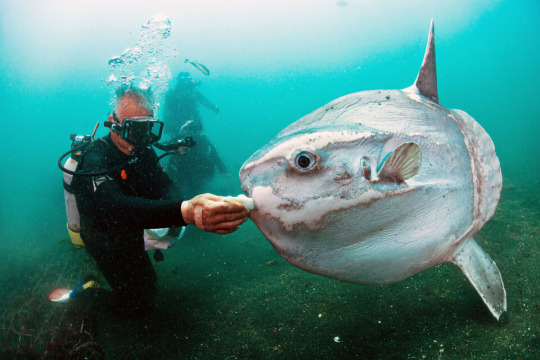
(Image: a SCUBA diver attempting to hand feed a small mola. End ID)
#wet beast wednesday#ocean sunfish#mola mola#name so nice you say it twice#countering sunfish slander#mola alexandrini#mola tecta#sharptail mola#Masturus lanceolatus#slender sunfish#Ranzania laevis#fish#fishblr#fishposting#marine biology#biology#zoology#ecology#animal facts#image described
171 notes
·
View notes
Note
i saw that video of the mola mola next to a scuba diver and went "ohhhh beautiful creature." though its partially because iv been through the Training of considering everything to have beauty despite nonconventionality. anyway do you have any species of sunfish you think are the prettiest nonconventionally
Oh yes, the video makes the sunfish appear HUMONGOUS at first! They’re big, but not quite that big ^^’ Exciting question! I think all the ocean sunfishes are good-looking in their own ways but my favourite in terms of looks would have to be sharptail sunfish. Perhaps my reasoning is exactly the sort of conventionally attractive reasoning you did not ask about but I enjoy their sleekness and their countershading patterns. They also have a pseudo-tail which I think is a cool and unique detail! It stands out among the ocean sunfishes.
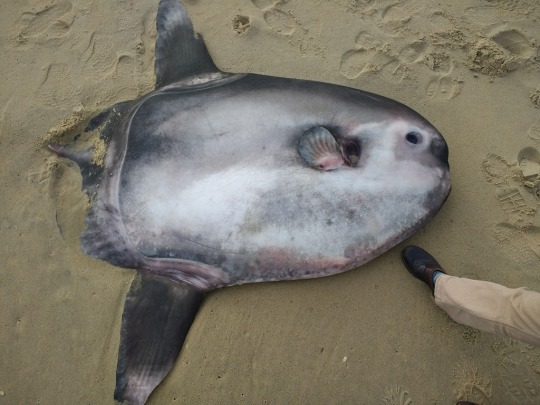

#its nicer to see beauty in nature! even in the bloodsuckers and the parasites and strange-appendaged animals#at the very least see value in their existence#anyway the sharptail sunfish rules B)#sharptail sunfish#sunfish#ocean sunfish#asks#eros-vigilante#animal death#tw animal death
40 notes
·
View notes
Text
Massive, very rare sunfish washes ashore in North Carolina
Massive, very rare sunfish washes ashore in North Carolina
NORTH TOPSAIL BEACH, N.C. (WNCN) — A rare 450-pound sunfish washed ashore on the North Carolina coast Wednesday.
The massive fish was more than 6 feet long when it washed ashore on North Topsail Beach near the Seaview Pier, according to officials with the North Carolina Museum of Natural Sciences.
The fish is called a sharptail mola sunfish – one of just five species of sunfish in the world.
The…
View On WordPress
0 notes
Text
An ASCII overview of the Molidae fish family:
Common sunfish
Mola mola
|\
Σ  ̄ ̄\
Σ C ° 3
Σ ____/
|/
Bumphead sunfish
Mola alexandrini
|\
Σ  ̄ ̄)
Σ C ° 3
Σ ___/
|/
Hoodwinker sunfish
Mola tecta
|\
Σ || ̄ ̄\
Σ= C ° 3
Σ ||____/
|/
Sharptail sunfish
Masturus lanceolatus
|\
Σ  ̄ ̄\
< C ° 3
Σ ____/
|/
Slender sunfish
Ranzania laevis
|\_______
( •o•
|/ ̄ ̄ ̄
#monterey bay aquarium#mola#molidae#mola mola#mola tecta#mola alexandrini#masturus lanceolatus#ranzania laevis#ocean sunfish#common sunfish#hoodwinker sunfish#bumphead sunfish#sharptail sunfish#slender sunfish#ascii me anything
10K notes
·
View notes
Note
You've brought up the three species of fish in the genus Mola before, but I was curious if you knew anything about the two others in the family Molidae? :o
I’ve only done The Family Mola so far, but not the two outliers. the Sharptail Mola looks pretty standard to what I’ve covered already but HOLY SHIT the Slender Sunfish is DEFINITELY getting a spot because LOOK.
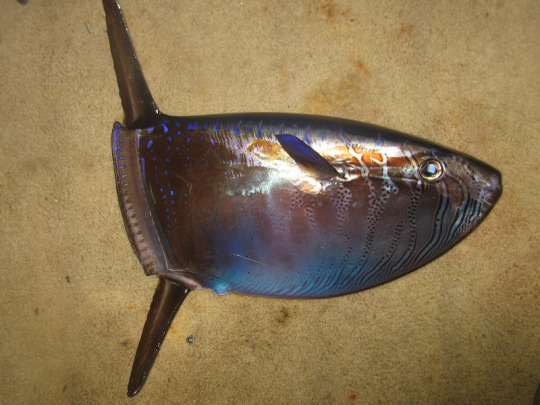
LOOK AT IT. LOOK.
147 notes
·
View notes
Photo

Very Rare Sharptail Mola Fish Encounter via /r/Animals http://bit.ly/2D57lJA
0 notes
Text
New Post has been published on Top 10 of Anything and Everything!!!
New Post has been published on http://theverybesttop10.com/heaviest-living-fish/
The Top 10 Heaviest Living Fish From Around the World
The Top 10 Heaviest Living Fish From Around the World
What makes a fish a fish? These swimming vertebrates all seem to have fins and gills, but not always in the same place or the same skin type, in fact, there are well over 25,000 species of fish all over the world and the list is always growing. From that list there are some fish that are fast, some that are small and some that are so big they eat all the other fish in the sea! These are the ten biggest fishes and their average fully-grown body weights…
The Top 10 Heaviest Living Fish From Around the World
Reef manta ray
10 – Reef manta ray – Average mass: 1.4 Tonnes
This might be the first Ray on this list, but it’s certainly not the last of them. Growing up to 11 ft wide they certainly spread their weight out and looks strangely peaceful and graceful in the subtropical waters it hangs out in.
Beluga sturgeon
9 – Beluga sturgeon – Average mass: 1.57 Tonnes
Just when you started to think River Monsters were not a real thing, along comes a giant sturgeon to prove you wrong. While most people know them as “beluga whales” they are indeed just a fish and one that is often hunted for its eggs.
Hoodwinker sunfish
8 – Hoodwinker sunfish – Average mass: 1.87 Tonnes
Believe it or not, this giant fish was only first discovered in 2017!!! Known to be yet another type of Mola fish it just goes to show that anything could still be out there in our seas and oceans.
Sharptail mola
7 – Sharptail mola – Average mass: 2 Tonnes
If it looks familiar its because it too is a Mola (half-fish shape) species of fish much like the Ocean sunfish. The biggest difference is the Sharptail mola has a small tale and the Ocean sunfish doesn’t.
(adsbygoogle = window.adsbygoogle || []).push();
Ocean sunfish
6 – Ocean sunfish – Average mass: 2.3 Tonnes
Said to be the heaviest bony fish in the world they are often as tall as they are wide, mostly wishing to eat jellyfish as they swim past them. Despite their gigantic size, they are no threat to humans and most other fish unless they get too near their mouths.
Giant oceanic manta ray
5 – Giant oceanic manta ray – Average mass: 3 Tonnes
It is, of course, the largest Ray fish in the world and can grow up to 23 ft wide! That super flat, streamlined body helps them to travel all over the world and are known to travel thousands of miles.
Tiger shark
4 – Tiger shark – Average mass: 3.11 Tonnes
The ‘Giant Sea Tiger’ gets its name thanks to its tiger stripes pattern going down its skin which does kind of resemble the stripes of a tiger. It is also known to kill more humans each year than all the species of Tigers known to man.
Great white shark
3 – Great white shark – Average mass: 3.32 Tonnes
If you have seen the film “Jaws” by Steven Spielberg you will know all about this shark. Sure, it doesn’t go out of its way to eat us, humans, like it did in the film, but it has been known to do so.
(adsbygoogle = window.adsbygoogle || []).push();
Basking shark
2 – Basking shark – Average mass: 19 Tonnes
It might be one giant shark, but it mostly eats plankton which makes it one of only 3 plankton-eating sharks in the world. It gets its name from the way it is often seen feeding on the surface of the water as if it is basking in the sunlight, much like us humans do on the worlds most amazing beaches.
Whale shark
1 – Whale shark – Average mass: 21.5 Tonnes
It might not be the fastest of sharks, but this beast of a fish is said to have been around since 60 million years ago so its as close to being a living dinosaur and you are ever likely to get.
0 notes
Photo
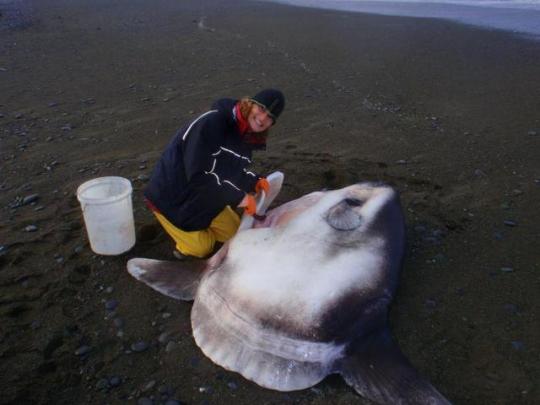
Massive Two-Ton Fish Species Discovered
It took scientists four years to find the newest species of the world’s largest bony fish.
By Hannah Lang
JULY 20, 2017
A new species of enormous ocean sunfish was discovered after an intensive search, making it the first species of this type of fish to be identified in 130 years.
Despite being the largest bony fish in the world and weighing more than two tons, sunfish are quite elusive, which made the four-year search difficult.
A team of researchers led by Marianne Nyegaard, a PhD student at Murdoch University in Australia, analyzed more than 150 sunfish DNA samples and recognized four distinct species—but only three of the species had been previously identified. (Read about a new species of a transparent frog discovered in Costa Rica.)
The first ever sighting and recording of the sharptail sunfish in the Galápagos is made by a National Geographic Expeditions crew in 2008. (Archive video.)
This discovery led Nyegaard to believe that there was an additional sunfish species that hadn’t been documented, but she had no idea what it might look like or where it might be hiding.
The research team decided to call the species the hoodwinker sunfish, or Mola tecta, which comes from the Latin word tectus, meaning hidden.It wasn’t until a year after this breakthrough that Nyegaard was able to see a hoodwinker sunfish up close. In 2014, she got a tip from a New Zealand fishery that four sunfish had washed up on a beach in Christchurch, and she flew down to see the evidence for herself.
Researchers from universities all around the world then collected and analyzed specimens from the fish to prove it was indeed part of this new species, and they looked at how it was different from the other three species of sunfish.
The hoodwinker sunfish has a slimmer and sleeker adult body shape and doesn’t develop lumps, bumps, or a snout, like other sunfish, according to the team’s paper published in the Zoological Journal of the Linnean Society.
Since the discovery, Nyegaard and her team have located the hoodwinker sunfish in New Zealand, off Tasmania, south Australia, South Africa, and southern Chile, suggesting the species range might be in colder parts of the Southern Hemisphere, Nyegaard wrote in an article for The Conversation.
The sunfish’s colossal shape allows it to maintain body temperature when it dives deep into the ocean to feed. The size also helps make it buoyant, so it can quickly return to the surface of the ocean to warm up. (Read about a car-sized stingray that could be the world’s largest freshwater fish.)
0 notes
Photo



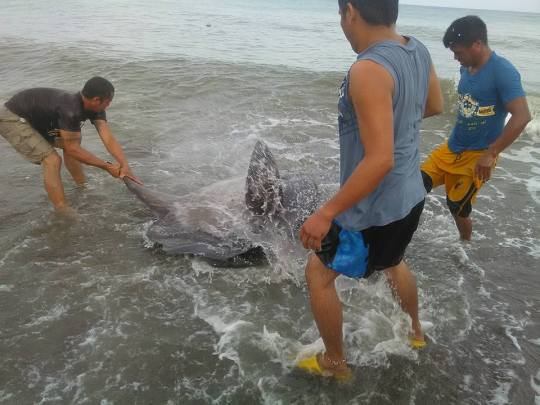
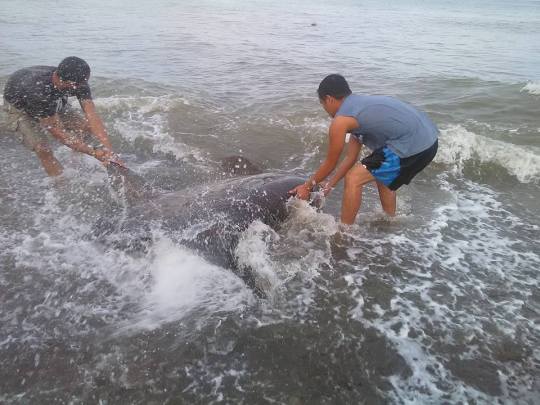
Another Ocean Sunfish found on the shores of Balabago, San Joaquin, Iloilo today.
Source: Ric Gaviloria Facebook, via Marine Wildlife Watch of the Philippines Facebook
This looks like it might be a Sharptail Mola (Masturus lanceolatus).
#sharptail mola#Masturus lanceolatus#sharptail sunfish#sunfish#sunfishes#ocean sunfishes#Molidae#Tetraodontiformes#fishes#teleosts#marine#Philippines#Iloilo#Panay#Western Visayas#Visayas#stranding#Marine Wildlife Watch of the Philippines
1 note
·
View note
Photo


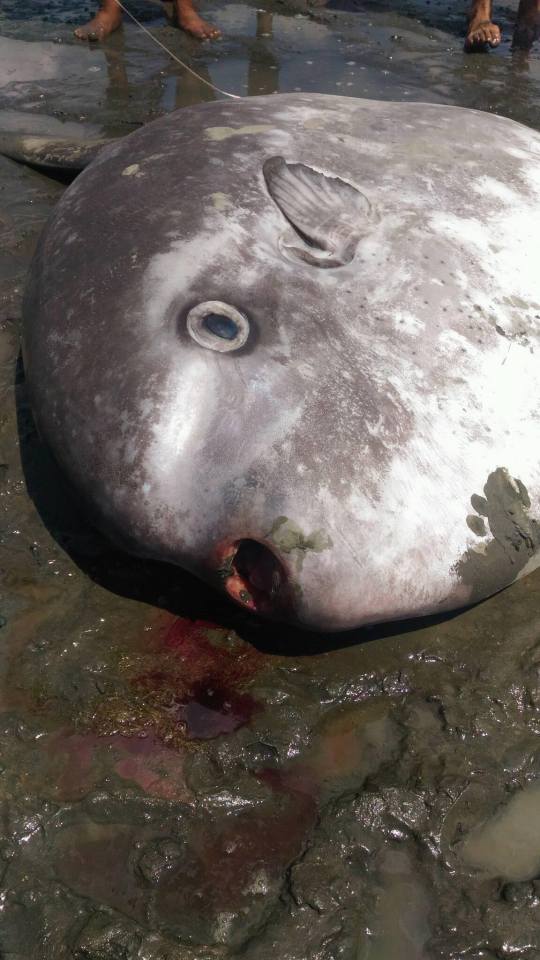
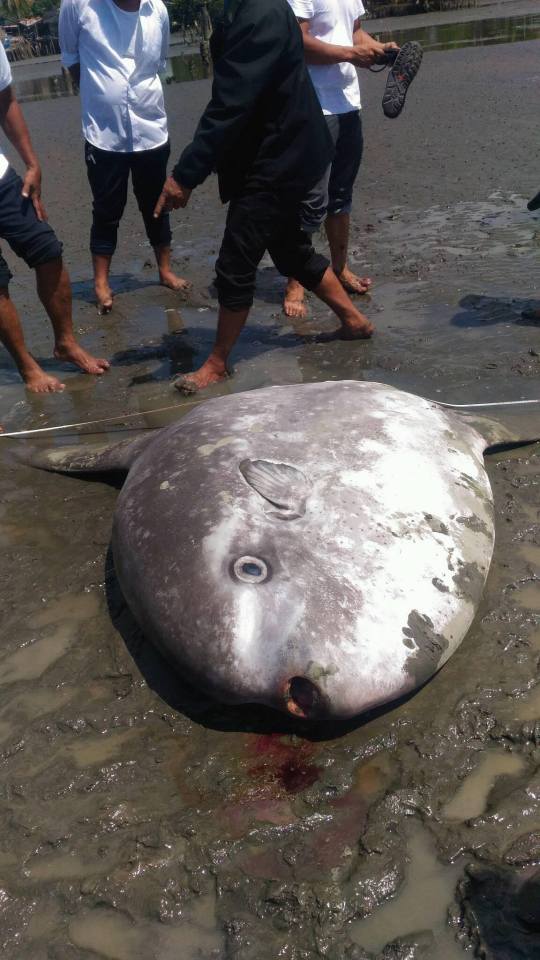
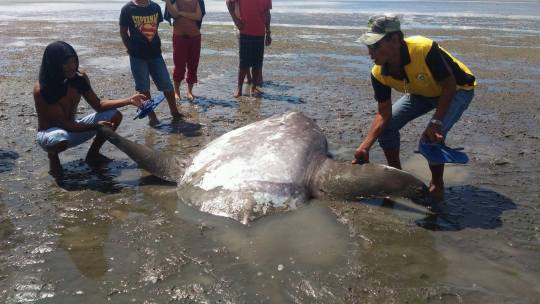

A Sharptail Mola (Masturus lanceolatus) found in the coastal area of Cagangohan, Panabo City, Davao del Norte today.
Source: Bfar-PFO Davao del Norte Facebook, via Marine Wildlife Watch of the Philippines Facebook
#sharptail mola#sharptail sunfish#Masturus lanceolatus#sunfish#sunfishes#ocean sunfishes#Molidae#Tetraodontiformes#marine#fishes#teleosts#Philippines#Mindanao#Davao del Norte#Davao#Panabo#Marine Wildlife Watch of the Philippines
11 notes
·
View notes
